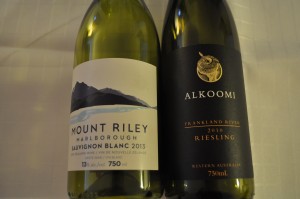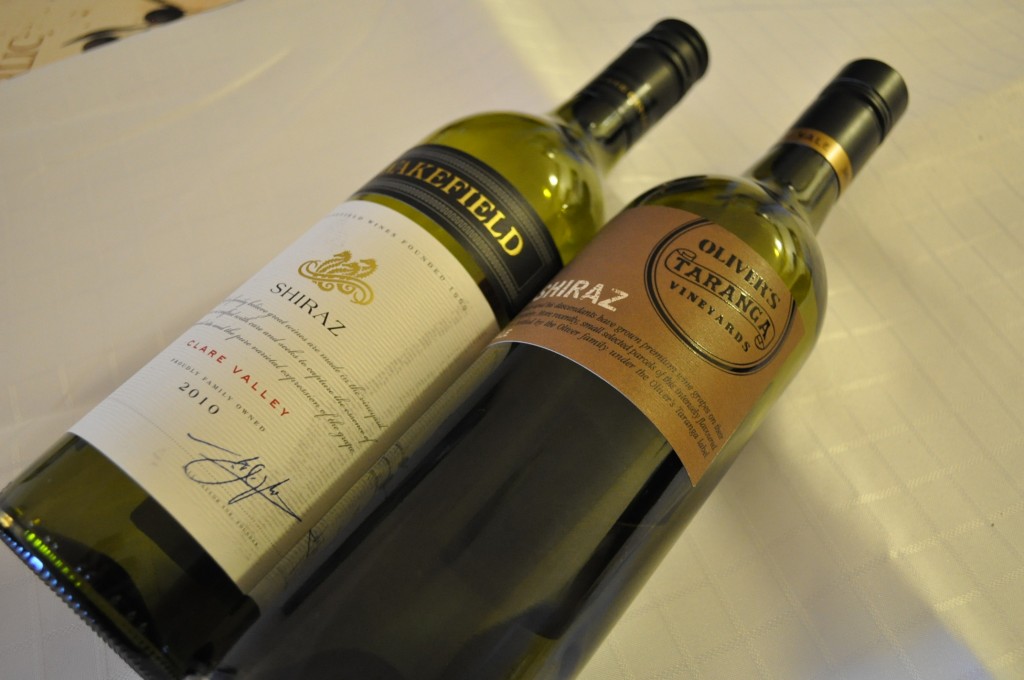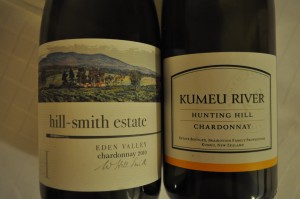Wine-a-roo
Wine-a-roo
Australia and New Zealand have been influential on the global market for just a couple decades. They both rose to this position very quickly due to their amenable climates for grape growing and by taking advantage of technology to produce quality wines. Our local shops have an abundant showcase of the most important appellations that export wine and many enthusiasts have some of their wines on their ‘go-to’ lists. Regions (or zones) such as Southeast Australia and Marlborough, and large wineries such as Wolf Blass, Kim Crawford, Lindemans and Oyster Bay are very familiar if you’ve perused the shelves. Although there are some great-valued and best-selling wines from these well-respected labels, this month’s meet went a bit further and grazed the surface of some of the smaller, regional gems. Let’s hop inside!
Palates awaken

The zingy Sauvignon and Riesling wines are a great start to the evening. Acidic wines stimulate the appetite.
You’ve heard me before about choosing vibrant light-bodied white wines to enliven the tastebuds before a meal. Both Australia and New Zealand have great offerings in Riesling and Sauvignon blanc, respectively. One of Australia’s Western state regions is Frankland River. The temperatures are cooled somewhat by seabreeze and, of course, being near a body of water such as this large river. The climate is amenable to Riesling and the wines are described as quite structured. The Alkoomi Riesling typifies this character with its racy acidity and lime notes which predominate. There is an intense minerality (saline) in this dry, light-bodied wine and the characteristic one may detect scents of either petrol or waxiness (lanolin). The tighly-wound structure should tame as the years pass. New Zealand’s Marlborough region is the most important for the industry; its Sauvignon blanc represents a benchmark for anyone wishing to familiarize themselves with this grape. Although the climate is cool, there is ample sunshine and a prolonged growing season to make this exceptional wine. Mount Riley Sauvignon blanc displays a great balance of cut grass, nettle, white grapefruit and lemon-lime zest. The palate reveals an an additional passion fruit flavour as it warms up before you enjoy the pleasing and lengthy finish. The two above wines are quite versatile and can be enjoyed with dishes and ingredients such as oysters or mussels, many whitefish, cream sauces and even fried foods (including tempura).
Smooth, sophisticated, reds
Pinot noir thrives in cooler areas and prefers drier vineyards to feel comfortable. It is New Zealand’s principal red grape and the dry, continental climate of Central Otago produces Pinot on the bolder side of the spectrum. Central Otago represents New Zealand’s southernmost wine region. Although it can become quite hot during the summer days the evenings are cool and this large range in temperatures can help the grapes to develop depth of flavour and complexity.

Central Otago Pinot noir is the boldest in New Zealand. And this Strathbogie Ranges Cabernet tasted as interesting as its label.
Waipara Hills Pinot noir was a crowd pleaser at the tasting. This wine is somewhere in between the cranberry, earthy style of cool-climate regions like Ontario and the fruit-forward style of warmer Californian appelations. This Pinot has a greater depth of ruby colour and it is cherry fruit that predominates for flavour. For complexity, there are notes of earth, autumn leaves and molasses. This wine was paired with both a Portobello mushroom risotto and a beet and arugula-spinach salad to play up the earth and vegetative qualities found in the grape.
Cabernet Sauvignon is one of Australia’s predominant red grapes. Fowles ‘Stone Dwellers’ Cabernet sauvignon is from the Strathbogie Ranges, northeast of Melbourne. The climate is quite temperate with a mid-summer average of only 20°C. This Cabernet is medium-weight with notes of blackberry, cassis, and green pepper. There is plenty of soft tannin to provide a pleasing structure.
Two bold Chardonnays
The principal white grape of Australia is Chardonnay and the Aussie style has traditionally been recognized as WEIGHTY and TROPICAL. I emphasize these because there was once a glut of these big brute Chardonnays on the shelves. However, the trend toward elegance, while still offering a variety of flavour notes is now in fashion. Often the winemaker will transfer the fermenting must into older barrels (hence, toward flavour neutral) in effort to only soften the wine rather than impart oaky flavours.
Hill-Smith Estate Chardonnay hails from South Australia’s Eden Valley where the cooler climate and prolonged growing season contributes to refinement, rather than over-ripeness. The flavours marry well and are not overbearing. Expect cooked pineapple, butter, nutmeg spice, and toasted marshmallow. The wine has a balanced creamy mouthfeel with structured acidity to make it less weighty on the palate. The finish is lengthy and very satisfying.
The North of New Zealand is where premium-quality Chardonnay can be easily found. Regions such as Gisborne, Hawke’s Bay and Auckland are some great examples. The Kumeu River Chardonnay ‘Hunting Hill’ lies just north of Auckland where the otherwise hot climate is tempered by the Tasmanian sea breezes. Although the wine is a 2009 vintage, we found it still youthful in nature as it felt as if it had a light spritz. Notes of fresh pineapple, tangerine, lime and popcorn kernel are most apparent. The acidity is still tightly wound for a medium-bodied wine. In a few more years the wine will become more integrated and be drinking exceptionally.
Sensational Shiraz
Neighbouring around the famous Barossa Valley in South Australia are McLaren Vale and Clare Valley. Both appelations produce some premium Shiraz, among other wines of course. Shiraz in the Australian style tends to have quite a bold presence with soft acidity, tannin. Much like the Chardonnay, the premium wines emphasize refinement rather than making a heavyweight fruit splash on the palate.

Australian Shiraz is a fruit prominent style and finer quality labels such as these have added complexity to offer.
Wakefield Shiraz, from Clare Valley, was just released into LCBO Vintages and has my vote for best value of the eight wines featured in this issue. For $17 you can enjoy a medium-full bodied red with notes of cherry, currant, black berry, leather, black pepper and velvety smooth tannin. If you feel like you want to splurge into the premium pricepoints Oliver’s Taranga Vineyards Shiraz, from McLaren Vale, dials up the complexity. On the backdrop of plum, cherry and blackberry sauce, this Shiraz almost tastes like mulled wine, perfect for the wintertime, with notes of cinnamon, clove and cedar.
Discovering Australia and New Zealand
Both countries have stellar wines ranging from crisp whites to deep luscious reds and even dessert wines (try a Semillon from Hunter Valley, Australia). There’s something for everyone.

Darn, I wanted to take my new corkscrew for a spin but most of the wines of Australia and New Zealand have screwcaps. Even some of the ultra-premium wines have done away with cork.
Now that we’ve been introduced to some of the regions, you can begin to appreciate the finer wines that offer lots of complexity and value. Lastly, but very important, if you unluckily happen to forget your hardware, no worries! The enjoyment of these wines is just a twist away – all of these wines are screwcapped.
Search
Recent Posts
- Рабочее Зеркало 1xbet На Сегодня официальному Сайт 1хбет
- Рабочее Зеркало 1xbet На Сегодня официальному Сайт 1хбет
- 1xbet Зеркало Рабочее 1xbet Официальный Сайт вход На Сегодня и 1хбет Казино
- 1xbet Зеркало Рабочее 1xbet Официальный Сайт вход На Сегодня и 1хбет Казино
- 1xbet Вход На официального Сайт Через рабочее Зеркало

